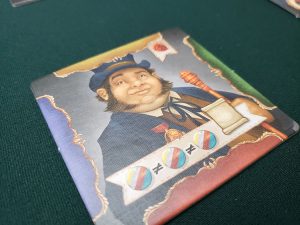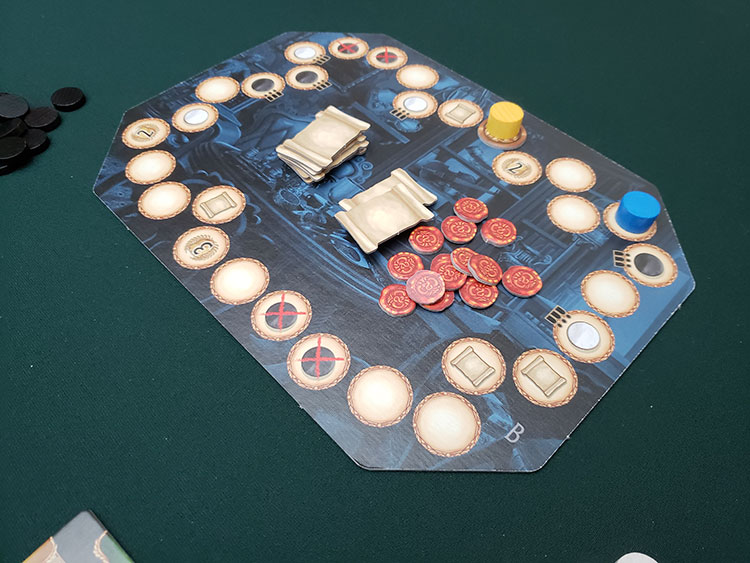 Game designers are like flavors of ice cream. Ok, maybe flavors of cookies or pie… Mmmmm…pie.
Game designers are like flavors of ice cream. Ok, maybe flavors of cookies or pie… Mmmmm…pie.
The point is, each designer takes a perspective on their subject. They infuse their designs with a type of style that comes to the forefront with each design. The hallmark of any good designer was that their individuality could be identified just by playing the game. Much like sniffing the cork of a wine bottle, playing a round of Castles of Burgundy should give you a hint it was designed by Stefan Feld.
It used to be, not so long ago, that most German-style games had themes that could have been sourced from dusty 1950s Encyclopedias. They were dry enough to choke a camel, and after playing a few of them in a row, their aesthetics justblurs together into a title called Cubes of the Renaissance.
One of those designers who is true to form is Rudiger Dorn. His titles have garnered praise, and his game design comfort zone are medium to light weighted Euro designs perennially teasing a Spiel des Jahres crown. These include Karuba, Istanbul, and the venerable Goa.
Mercado is a simpler work. It’s a bidding style game with a victory point race. It takes 30-60 minutes for 2-4 players. For the most out of this effort, get thyself a quartet.
Gameplay Overview:

Gamers will need to journey back to the innocent days of the 2000-aughts (maybe early 2010s) to find another game in the vein of Mercado. Players are rich (noble presumably) customers shopping for fine wares in the Amazon Prime of renaissance Europe. By collecting the most valuable items with the fewest turns of placing money tokens, each player aims to race up a victory point track. The one who completes a circuit first is the winner.
Each player starts with a collection of various colored coins in their purse (an opaque bag). On a turn, they draw 3 coins from the bag to place on various items. Each item will have a different requirement for the price. Some might be 2 gold and 1 silver coin while another will be 4 coins of unique colors.
Once a player has paid out their coins to items, the market as a whole is evaluated to see which items have had their prices met. Think of this like layaway with the first person to finish paying for an item getting to keep it. That player gets the victory points and any other bonuses that come with it.

The purchasing player moves the coins paid to a holding area of their player board. Other players put them back in their bag. They have lost the time invested in placing those coins.
However, instead of drawing 3 coins from their bag, a player may also put all coins on their player board back into their bag, recycling the system. Turns continue like this until one player’s score marker comes back to the beginning.
There are some pitfalls to the whole cycle. Black coins may be drawn from the bag which are worthless. The only benefit being the knowledge that they can’t be drawn later until the bag recycles. The score track also has some spaces that provide positive or negative effects so purchasing an item for just the right number of points can be a huge boon. For catch-up mechanisms, two static locations on the board can be used to exchange coins of one type into another.

Game Experience:
As lifeless as this title seems, with the right group this is a gem. There are no flashy pieces. The art is serviceable and decorative, if unexciting. The whole production feels “nice”.

However, this title is not meant for gamers. Grandma is visiting and she doesn’t want to play Dungeons & Dragons: Tomb of Annihilation. Elena’s boyfriend is stopping by the game group, and he hasn’t even played Ticket to Ride. An upcoming visit from a couple of non-initiated pre-teen nieces and nephews is soon, and there’s a need for a lighter game for sibling competition. These are the scenarios for Mercado. It’s a friendly, family style competitive game with some bite.
As a gamer, yours truly was prepared to snub this work and write it off as “just another tired Euro”. However, to new gamers, this is just the right speed at just the right game weight. It doesn’t intimidate with its components or rules and players still feel like there are a wealth of competitive decisions. And, point in fact, there are.
Those decisions are more tactical from turn to turn based on what coins are revealed from the bag, and the items available for purchase may slightly benefit one particular player more. But this is no grand, overly long strategy meal. This is a quick bite of competitive shopping. That’s the hook with which Mercado shines.
Final Thoughts:
For player unfamiliar with the gaming hobby, Mercado is as good an introduction as Splendor, another wonderful game. The play is quick and engaging with just enough tactics in a gateway package. Take this one to Thanksgiving dinner. Take it to Sunday dinner. Mercado is not modern. It’s not flashy. It’s just good.
Final Score: 3.5 Stars – A perfect gateway game for new gamers, even with the older game feel.
 Hits:
Hits:
• Fun tactics with each turn
• Not too heavy for the time expectation
• Components aren’t flashy but drawing from the bag is fun for new gamers
Misses:
• Feels like an older style design





















